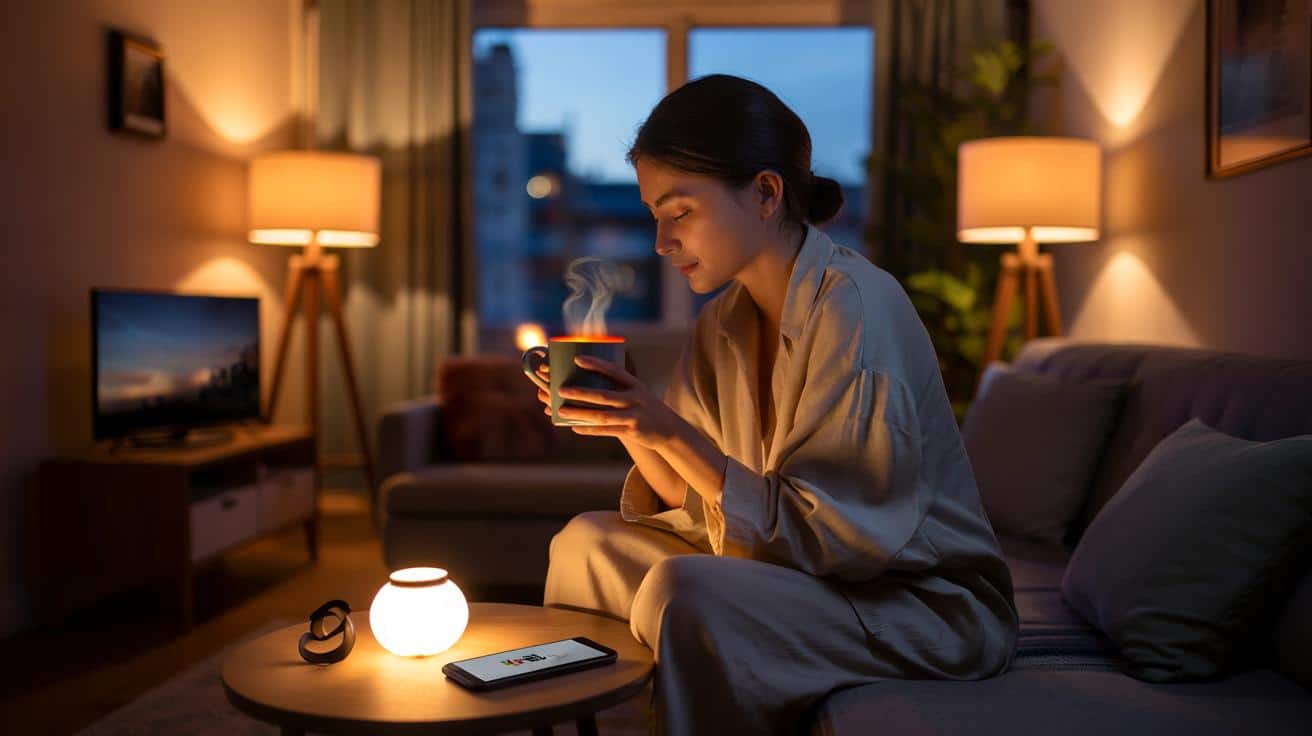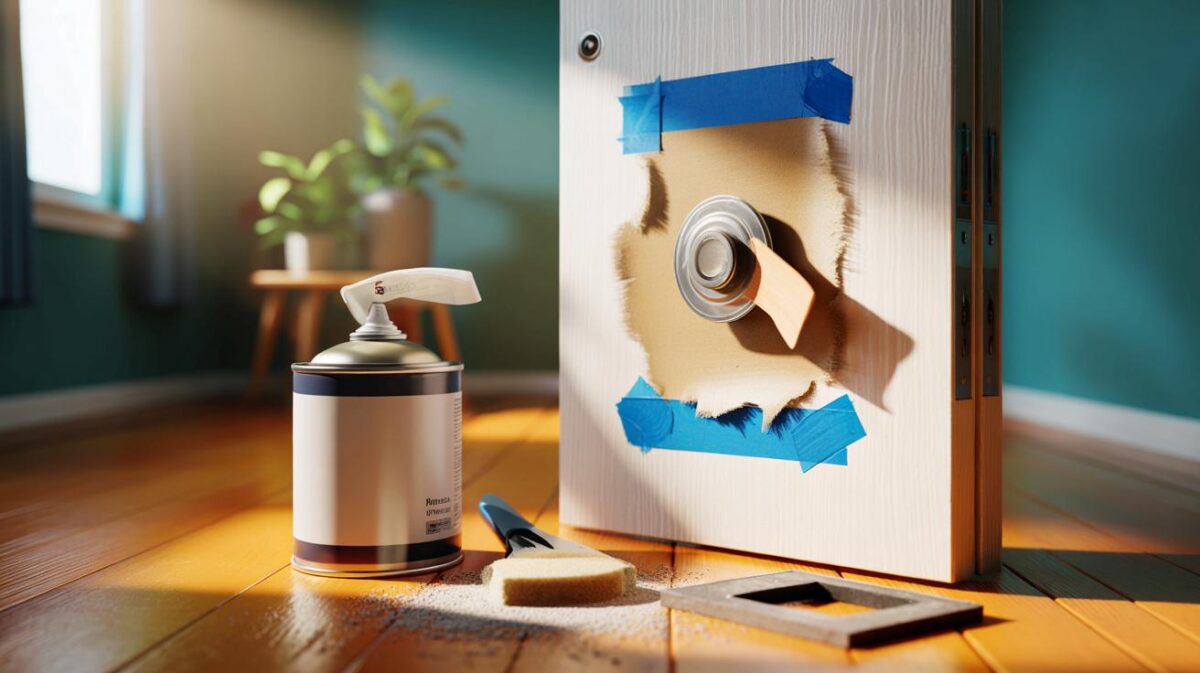You tweak the pillows, you count minutes, you wonder if tomorrow’s meeting will spot the under-eye shadows. Something in the evening is off. The fix is smaller than you think.
On a Tuesday that smelled of drizzle and reheated pasta, I watched a London flat change mood with a thumb. The dimmer slid down, the kitchen dropped from bright white to a soft amber, and the room exhaled. The kettle murmured, the phone went face-down, a single lamp by the floor did the heavy lifting. *You could almost hear the nervous system unclench.* Fifteen minutes later, the glassy buzz behind the eyes was gone, replaced by a warm, sleepy heaviness you don’t buy in a bottle. The night felt older, friendlier, like a pub turning down the music at last orders. The trick isn’t in your mattress.
The quiet power of less light
Here’s the blunt truth: our homes now glow like daytime long after the sun has ducked out. Ceiling LEDs, kitchen spots, and a phone inches from the face send a daylight message to a brain that desperately needs to hear “evening”. We evolved to read sunset, not spreadsheets. The result is a confused body clock, a drowsiness signal that never quite lands, and a sleep that feels shallow and skittish. Drop the brightness, and your biology does the rest. The body recognises “night” again. Your eyelids follow.
There’s fresh evidence backing this ordinary magic. Wearable data sets in the millions have started to show a simple pattern: on nights with a darker pre-bed hour, people fall asleep faster and report fewer wake-ups. In lab studies, even 50–100 lux — think a bright hallway — can push melatonin timing later than you’d like. Swap that for a lamp at knee height, with a warm bulb, and melatonin rises sooner, like a tide turning at the right moment. A woman in Manchester I spoke to tried it for one week: same bedtime, same life. Her phrase was lovely and plain — “I felt sleep catch up with me, not the other way round.”
It isn’t mystical. The master clock behind your eyes is wired to light, and it cares about two things: how bright the light is and when it hits. Blast it late with white overhead glare and you shove the clock forward, creating a jet-lag you never flew for. Dim the room so faces are lit, but walls aren’t, and that internal clock eases into night mode. Heart rate dips. Core body temperature begins its quiet slide. Your sleep pressure, patiently built through the day, finally gets to knock on the door and be let in.
How to try the 60‑minute dim‑down tonight
The habit is disarmingly simple: for the final hour before bed, live in **warm, low light** and **no bright screens**. Switch off overheads. Use one or two lamps placed low — waist height or below — with bulbs around 2200–2700K. Pull brightness down on tablets and TVs, or park them altogether. If you can, let your phone sit in another room, or flip it into greyscale and do-not-disturb. This is your **60‑minute dim‑down**. Nothing fancy. Just less light, closer to sunset light, for long enough that your body clock can hear the message.
Most people fall at the same hurdles. They keep the kitchen lit like a stadium while tidying up. They scroll right up to lights-out “just for a sec”. They think a single candle will do it while the hallway blares. Be kind to yourself and set the scene once, then reuse it. A plug-in dimmer for a lamp. A warm bulb, not the blue-leaning “cool white”. A small ritual you half look forward to — a book, a mug, a mint tea, a five-minute list of tomorrow’s jobs. Let’s be honest: nobody does that every single night. If you miss a day, shrug and start again tomorrow.
We’ve all had that moment where you stare at the ceiling and bargain with your brain; this habit trims those negotiations before they begin. Think of light as a volume dial on wakefulness and turn it down before you try to sleep. Your room doesn’t need to be dark yet — it needs to be dusky.
“Light is the language of your body clock. In the evening, speak softly.”
- Kill overheads; use two low lamps with warm bulbs.
- Put phones and tablets away, or run greyscale at lowest brightness.
- Keep TV small and distant, or switch to audio for the last 20 minutes.
- Do calm chores in low light: fold laundry, prep breakfast, pack a bag.
- Aim for roughly 60 minutes. Even 30 helps on busy nights.
Why it works on busy, ordinary lives
Modern evenings are noisy with tasks and notifications, and your nervous system tries to match that tempo. Dimming the light steals the drumsticks. It quietly lowers arousal, which is a fancy way of saying your body stops bracing and starts letting go. Heart rate variability ticks up, eyelids get heavy, thoughts lose their edges. You don’t need monk-like discipline to pull this off. You need a switch, a lamp, and the willingness to let the room feel like late evening again. The pay-off is sleep that lands earlier and sinks deeper.
Parents tell me they use the dim‑down as a corridor, guiding everyone through the last hour without turning into referees. Couples use it as a social nudge — we talk, we potter, we keep it cosy. Flatmates use it to draw a line under work-from-home that lacks a proper commute. On solo nights, you can pair it with something pleasantly boring: a paperback, a slow podcast, a few slow stretches. The body loves patterns. Give it a repeated signal and it gets faster at responding.
There’s a side benefit nobody talks about: your home looks better. Harsh ceiling light flattens everything; low light adds texture and ease. Dimming also makes late-night snacking less tempting and emails look less urgent because both live in bright, task-mode worlds. You step out of that world on purpose. If you need a motto, borrow this: small lights, slower night. It’s tidy. It sticks. And it’s the kind of habit you can keep through travel, guests, or the odd chaotic week without swearing off real life.
The small ritual that gives more than it takes
Give your evenings a softer edge and they give you back real sleep: the kind where you wake and your jaw isn’t clenched, where the day feels wide instead of narrow. The dim‑down doesn’t fix everything — noisy neighbours, a restless baby, a racing mind all have their say — but it stacks the deck in your favour. It’s free, it’s repeatable, and it respects how your biology is built. You might notice a gentler mood, fewer 3am wake-ups, mornings that don’t begin with a jolt. You might also notice how different the world feels when you end the day on purpose. Try it for three nights. Notice what changes. Share it with someone who’s tired and quietly desperate for a win.
| Key points | Detail | Reader benefit |
|---|---|---|
| Dim for 60 minutes | Low, warm lamps; overheads off; phones away or dimmed | Faster sleep onset and calmer pre‑bed mood |
| Light sets your body clock | Even modest evening brightness delays melatonin and sleepiness | More predictable bedtimes and fewer middle‑of‑the‑night awakenings |
| Make it easy to repeat | Use dimmers, warm bulbs, and a simple wind‑down ritual | A habit that survives busy days and still pays off |
FAQ :
- Does this work if I’m a night owl?Yes. Night owls often have a naturally later clock, and evening brightness pushes it later still. Cutting light gives your clock a chance to drift earlier, making sleep come more easily.
- What if my only light is a bright ceiling fixture?Use a cheap plug‑in lamp with a warm bulb and park it low on a shelf or the floor. Even one cosy pool of light beats a room full of glare.
- Can I still watch TV?Keep the screen smaller and further away, drop the brightness, and stop 20 minutes before bed. Switch to audio for the last stretch — radio, audiobook, or a gentle podcast.
- Is this safe if I have insomnia?It’s a low‑risk, supportive habit many clinicians recommend. If insomnia persists for weeks or affects your day, speak with a GP or a sleep specialist about CBT‑I.
- What about blue‑light glasses?They can help some people, but lowering overall brightness and moving light sources lower and warmer tends to deliver bigger, more reliable gains.








